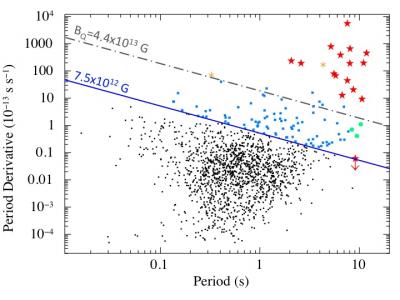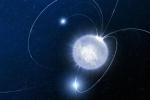Magnetars form a class of neutron stars with a much higher (100-1000 times) magnetic field with respect to common rotation powered pulsars. This extreme magnetic field is currently believed to be the cause of their unpredictable and intense activity. But the observation by an international team, which includes a researcher from AIM/Service d’Astrophysique of CEA-Irfu, of the magnetar dubbed SGR 0418+5729 casts some doubts about this classification. By observing the rotation period of this object for more than one year, scientists have derived that the intensity of the surface magnetic field of this magnetar was much more fainter than that of other objects of this class, and similar to the one of ordinary pulsars. The magnetar-like activity could then be a phase in the life of some pulsars, and magnetars could be potentially much more numerous within our Galaxy. This study has been published in Science Express Magazine on the 14th of October 2010.
Regular tempo
In June 2009, the Gamma-Ray Burst Monitor (GBM) instrument on board the Fermi satellite detected two short and intense flashes of high-energy radiation from a give region in the sky. The characteristics of this new source dubbed SGR 0418+5729 immediately pointed towards the magnetar class (short and bright X-ray flashes, slow rotation period, and spectral properties). Nevertheless, something stimulated the curiosity of the scientists: the star’s rotation period, 9.1 seconds, was not evolving. This result was surprising, since all known magnetars strongly spin down, up to 10 microseconds per day. The team of scientists decided to follow-up this source by using four distinct X-ray satellites (Chandra, RXTE, and Swift NASA satellites and the ESA one XMM-Newton). After 500 days of observation, the conclusion is the same: the rotation period did not change by more than a quarter of microsecond, no variation could be measured.
A peculiar magnetar
These observations have an important immediate consequence: they put an upper limit to the intensity of the surface magnetic field of the neutron star. In fact, in the framework of the canonical model of rotating neutron stars, there is a simple relation that ties the magnetic field to the rotation period of the neutron star and to its variation with time (derivative). For a give period, the stronger is the variation, the more intense is the magnetic field. The value calculated for SGR 0418+5729 is of 7.5x1012 Gauss, much smaller than the average magnetar value of 1014-15 Gauss. It represents by far the faintest magnetic field ever measured for a magnetar. Its value places SGR 0418+5729 within the distribution of the magnetic field values of regular pulsars whose average value is 1012-13 Gauss. Another consequence of this measurement, the estimated age of SGR 0418+5729 is 24 million years, much larger than the canonical age of the magnetars discovered up to now (200-200 000 years).

Period distribution (in seconds) of the pulsars and the magnetars as a function of the spin-down (vertical scale in 10000th of nanoseconds per second). The black and blues dots represent ordinary radio pulsars, the red stars are the magnetars. SGR 0418+5729 is the red star with the vertical arrow (at right in the plot). It occupies a peculiar place among the magnetars. The blue line represents the objects, which have a surface magnetic field of 7.5x1012 Gauss, upper limit for SGR 0418+5729.
Family reunion
The observation of SGR 0418+5729 indicates that a magnetar-like activity can take place even if the surface magnetic field of a neutron star is relatively faint, close to the one of radio pulsars. Scientists think that the magnetar model should now incorporate this new result. They note however that the internal magnetic field of the neutron star can be sufficiently strong to induce the neutron star crustal deformations that are a key ingredient for the magnetar activity episodes. The authors conclude that SGR 0418+5729 is maybe the first example of a population of “old” magnetars, whose main energy source is the internal magnetic field. On the other hand, a fraction of ordinary pulsars (the blue dots placed close to SGR 0418+5729 on the plot above) could manifest themselves through magnetar-like activity episodes. Being the number of known pulsars in our Galaxy much larger than that of magnetars (2000 versus less than 20), the latter could be potentially much larger, since SGR 0418+5729 could just be the first sign of a reunion between these tow families of sources.
Contact : (CEA)
Publications :
« A low-magnetic-field Soft Gamma Repeater »
N. Rea, P. Esposito , R. Turolla, G. L. Israel, S. Zane, L. Stella , S. Mereghetti, A. Tiengo, D. Götz , E. Gogus, C. Kouveliotou
Revue Science express, 14 octobre 2010, version électronique : arXiv:1010.2781 ou télécharger le fichier pdf (350 Ko)
Voir : ESA press release
NASA press release
See also : - "Giant Magnets in our Galaxy" , 2008, November
• Structure and evolution of the Universe › High energy cosmic phenomena and astroparticles Structure and evolution of celestial bodies
• Department of Astrophysics (DAp) // UMR AIM




